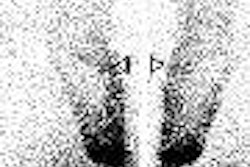SAN DIEGO - A computer-aided detection (CAD) scheme developed by a group at the University of Chicago offers a high sensitivity for detecting interval changes on bone scintigraphy. The scheme was also found to reduce reading time and reveal changes in soft tissue, according to a presentation this week at the Society of Nuclear Medicine (SNM) meeting.
"Detecting and characterizing interval changes on bone scans can be difficult and time-consuming if changes are subtle or if there are many lesions to analyze," wrote Dr. Daniel Appelbaum and colleagues in their SNM poster presentation. Changes on bone scintigraphs can offer valuable information on osseous tumor response to chemotherapy and radiation treatment, they stated.
Appelbaum's group developed a CAD scheme for producing and interpreting temporal subtraction images between two successive whole-body scans and performed their study to evaluate the scheme's clinical utility. A similar temporal subtraction technique has previously been described for detecting interval changes between two successive chest radiographs, they stated, but not used with bone scans (Medical Physics, March 1994, Vol. 21:3, pp. 453-461).
For the current study, the group retrospectively looked at 58 pairs of successive whole-body scans including anterior and posterior views. Three nuclear medicine specialists reinterpreted all pairs of initial and follow-up bone scans independently, and identified interval changes between the two images on a lesion-by-lesion basis.
The following multistep temporal subtraction scheme was used:
- Initial image density normalization
- Image matching for paired images in size, orientation, and appearance
- Temporal subtraction nonlinear warping
The last step was developed at the university and was used on the temporal subtraction images, which demonstrated interval activity and/or size that was new, increased, or decreased. These images were then analyzed using the CAD technique.
The results showed that by using the CAD scheme 94.7% of new/increased lesion activity and 92.7% of decreased lesion activity was detected. Sensitivity for all lesions was 95.3%. Reader sensitivity climbed from 59.5% to 73%. The mean read time dropped from 134 seconds to 94 seconds.
However, there were misregistration artifacts because of patient motion and slightly noisier images. Also, there were some instances of false positives, which the authors discuss in more detail in a paper submitted to Medical Physics.
"Bone scans are generally much more sensitive for bone pathology than conventional radiology.… While MRI rivals bone scans for sensitivity, whole-body, head-to-toe imaging is not practical with MRI," the group wrote in their SNM poster.
In fact, one unexpected additional benefit of using the CAD scheme was the detection of changes in soft tissue, they stated. They suggested that CAD could be used as a screening tool on bone scans, especially because lesion-by-lesion detection can be very time-consuming. The next step is an observer study in which the readers will view both temporal subtraction and CAD images.
By Shalmali Pal
AuntMinnie.com staff writer
June 5, 2006
Related Reading
Digital x-ray unreliable for evaluating bone healing, May 31, 2006
PET and PET/CT best bone scan in detecting breast metastases, June 20, 2005
Copyright © 2006 AuntMinnie.com



















